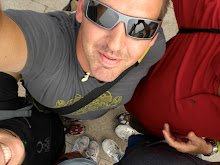It is about a hundred miles out of Portland to make the way up to Goldendale, Wa. There you'll find a public observatory housing a homemade telescope with a two foot mirror. Enough to bring some wicked distant points of light into view.
Before it is even dark, Arcturus beams out, road weary and having started the trip long ago, flickering like tired eyes. Three years older than me, the event that I see through the eyepiece is hard to understand: This great bursting collaboration of nuclear fusion, time and distance is lost. As we see it happening now, it has really happened 36 years ago. It has only taken this long for the light to travel to us. It happens thousands of times simultaneously each clear night, each star is a different story, a different traveler from a different time. But here and there must not be so different. In fact, at night the horizon begins to blend with the sky: The stars blipping on, the red indicator lights on waves of wind turbines, the bare black landscape with occasional windows lit comfortably, clouds creeping from the south, and a warm, but far-away bed. It's all only distance and proximity. Filament and fusion. And it is worth the trip. If Arcturus is traveling over 2oo trillion miles to meet you, you might as well amble out an easy hundred or so.

No comments:
Post a Comment